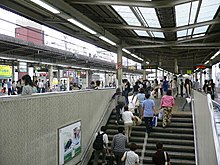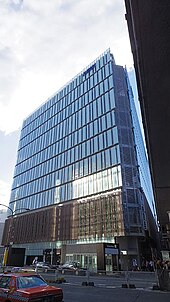Kichijōji Station
| Kichijōji ( 吉祥寺 ) | |
|---|---|
|
North entrance with Atré shopping center (March 2018)
|
|
| Data | |
| Location in the network |
|
| Platform tracks | 6th |
| abbreviation | JB02 / JC11 / IN17 |
| opening | December 30, 1899 |
| location | |
| City / municipality | Musashino |
| prefecture | Tokyo |
| Country | Japan |
| Coordinates | 35 ° 42 '11 " N , 139 ° 34' 47" E |
| Height ( SO ) | 55 m TP |
| Railway lines | |
| List of train stations in Japan | |
The Kichijōji station ( Japanese 吉祥寺 駅 , Kichijōji-eki ) is a train station on the Japanese island of Honshū , which is operated by the railway companies JR East and Keiō Dentetsu . It is located in the Tokyo prefecture in the area of the city of Musashino , more precisely in the district of Kichijōji .
links
Two neighboring train stations that are not operationally connected to each other bear the name Kichijōji. In the through station , the Chūō main line from Tokyo via Shinjuku to Shiojiri (whose tracks are identical to those of the Chūō high-speed railway line Tokyo – Shinjuku– Takao ) and the Chūō-Sōbu line from Mitaka via Akihabara to Chiba run parallel to each other . These three lines are operated by the JR East railway company. In addition, Chuo SOBU line between Mitaka and Nakano of metro trains on the company Tokyo Metro shared leading to the Tozai-line by Nishi Funabashi- and Tsudanuma by bound are. The south adjacent terminal station is the terminus of Inokashira line of the railway company Keio Dentetsu to Shibuya .
A pair of trains of the Narita Express ( 成 田 エ ク ス プ レ, ), which connects Takao with Tokyo-Narita Airport , stops in Kichijōji every day . The offer regional services on the Chuo train line includes the Kakueki-Teisha -Nahverkehrszüge and Kaisoku - and Tsūkin kaisoku - fast trains with headways of a few minutes. The starting points are usually Tokyo in the east and Takao and Ōtsuki in the west. Some of these trains run beyond Ōtsuki to Kawaguchiko or switch to the Ōme line in Tachikawa .
Local traffic through the inner Tokyo suburbs is handled on the Chūō-Sōbu line, which has its own tracks and is operationally independent of the other two lines. During rush hour, the train sequence is only two minutes, with several trains running beyond Mitaka to Musashi-Koganei and only turning there. During the day, nine trains are offered every hour. Except during the morning rush hour and in the late evening, up to five subways of the Tōzai line run every hour via the nominal terminus Nakano to Mitaka.
There is a large number of local and express trains on the Inokashira Line. They run alternately every six minutes during rush hour, which results in a three-minute cycle. At the other times, there is usually a ten-minute cycle. There is a bus terminal each on the north and south of the station forecourt , they are served by over 50 lines of the companies Kantō Bus , Keiō Bus , Mubus , Odakyū Bus and Seibu Bus .
investment
The station is in the middle of a densely built-up business district with numerous department stores, shopping streets, restaurants, cafes and shops. About three hundred meters southwest of it is Inokashira Park , where the Kanda River rises.
The part of the facility operated by JR East is a through station oriented from east to west and is located on a wide viaduct . It has four tracks, all of which are used for passenger traffic, and are located on two covered central platforms . The northern pair of tracks is reserved for high-speed and long-distance traffic, the southern for local traffic. The station building is located under the viaduct and is accessible from both sides; elevators and escalators lead up to the platforms. There is an underpass at the eastern end of the platforms. The complex is surrounded by two shopping centers . On the north side is the Atré Kichijōji operated by a JR subsidiary , on the south side is the eight- story Kirarina Keiō Kichijōji operated by Keiō Dentetsu . In the latter, the northern end of the double-track terminus of the Inokashira line, which has two side platforms , is integrated in an elevated position .
In the 2017 fiscal year, an average of 215,727 passengers used the station every day (only entrances). Of these, 143,313 were accounted for by JR East and 72,414 by Keiō Dentetsu.
Tracks
JR East
| 1 | ▉ Chūō-Sōbu line | Mitaka |
|
|
through-bound trains to Mitaka | |
| 2 | ▉ Chūō-Sōbu line | Nakano • Shinjuku • Akihabara • Nishi-Funabashi • Chiba |
|
|
Looped trains to Nakano • Iidabashi • Ōtemachi • Nishi-Funabashi • Tsudanuma | |
| 3 | ▉ Chūō rapid transit line | Mitaka • Tachikawa • Hachiōji • Takao |
| 4th | ▉ Chūō rapid transit line | Nakano • Shinjuku • Tokyo |
Keiō Dentetsu
| 4th | ▉ Inokashira lineage | Meidaimae • Shimo-Kitazawa • Shibuya |
history
The Chūō main line had existed since 1889, but the trains initially ran for ten years without stopping. On December 30, 1899, the private railway company Kōbu Tetsudō took the Kichijōji station for passenger and freight traffic into operation. Nearly seven years later, the KOBU tetsudō was born on October 1, 1906 nationalized . The Teito Dentetsu , a private railway company belonging to the Odakyū group , extended the Teito line beginning in Shibuya on April 1, 1934 from Inokashira-kōen to Kichijōji. On May 1, 1940, the Teito Dentetsu merged with the Odakyū Dentetsu , which in turn temporarily merged with Tōkyū two years later . As a result of a restructuring of the group, the Teito line came on June 1, 1948 under the current name Inokashira line in the possession of the Keiō Teito Dentetsu (since 1998 Keiō Dentetsu ).
On April 5, 1965, the Japanese State Railways stopped cargo handling on the Chūō main line. This created space for a significant expansion of the line, in particular relocating it to a viaduct and building an additional double lane. Thus, from April 6, 1969, four through tracks were available. In addition, two new reception buildings with integrated shopping centers were built: in 1969 the Kichijōji LonLon over the Chūō main line and in 1970 the Echo terminal over the Inokashira line. As part of the privatization of the state railway, the older part of the station went into the possession of the new railway company JR East on April 1, 1987 . In 2009/10, JR East subjected the Kichijōji LonLon to a comprehensive renovation and gave it the new name Atré Kichijōji . Keiō Dentetsu, however, had the Echo Terminal demolished in April 2010 ; in its place a new building called Kirarina Keiō Kichijōji was built , which was opened in April 2014.
Adjacent train stations
|
←
|
Lines |
→
|
||
|---|---|---|---|---|
|
Ogikubo Nishi-Ogikubo (Mon-Fri) |
|
Mitaka | ||
| Nishi-Ogikubo |
|
Mitaka | ||
| Beginning |
Keiō Dentetsu |
Inokashira-kōen | ||
Web links
- JR East Station Information (Japanese)
- Keiō Dentetsu station information (Japanese)
Individual evidence
- ↑ a b JR 時刻表 2019 年 3 月 号 (JR timetable March 2019). Kōtsū shinbunsha, Tokyo 2019.
- ↑ 井 の 頭 線 吉祥寺 ◇ 渋 谷 方面 平日 2019 年 2 月 22 日 現在. Keiō Dentetsu , 2019, accessed December 12, 2019 (Japanese).
- ↑ 各 駅 の 乗車 人員. JR East , 2018, accessed December 12, 2019 (Japanese).
- ↑ 東京 都 統計 年鑑 平 成 29 年. (Tokyo 2017 Statistical Yearbook). Tokyo Metropolitan Government , 2018, accessed December 12, 2019 (Japanese).
- ↑ 停車場 設置. In: Official Gazette. National Library of Parliament , January 10, 1900; accessed December 11, 2019 (Japanese).
- ↑ Hirokazu Terada: デ ー タ ブ ッ ク 日本 の 私 鉄 . Neko Publishing, Tokyo 2013, ISBN 978-4-7770-1336-4 , pp. 66-67, 227-229 .
- ↑ Tetsu Ishino (Ed.): 停車場 変 遷 大事 典 国 鉄 ・ JR 編 (station change directory JNR / JR) . JTB, Tokyo 1998, ISBN 978-4-533-02980-6 .




